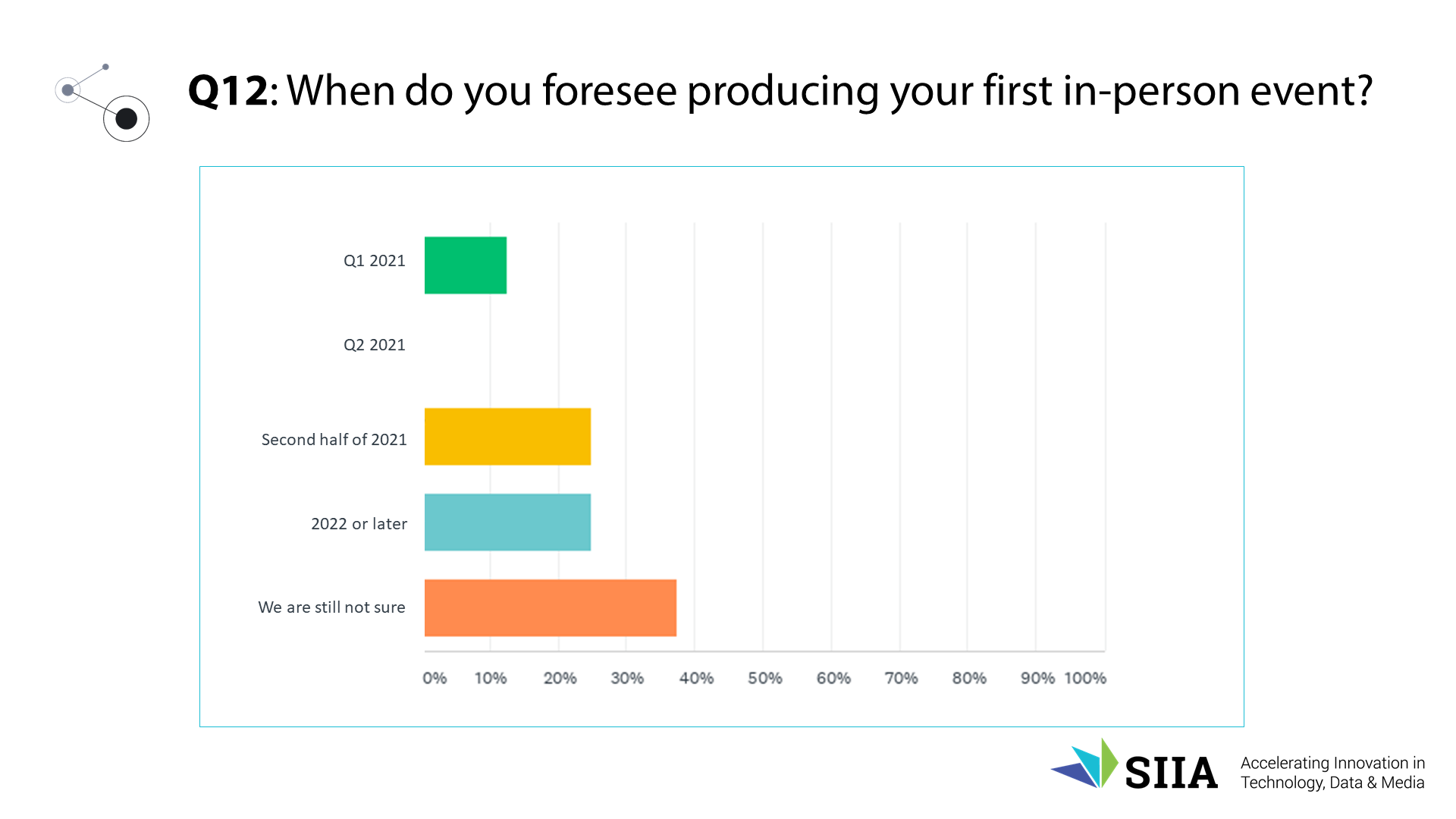A ray of hope in our collective slog through the COVID-19 crisis: 40 percent of respondents to a recent (and unscientific) SIIA-Connectiv survey of B2B media and information companies say revenue has already returned to pre-pandemic levels.
However, that’s tempered by the fact that the second largest group of respondents (30 percent) say they don’t know when revenues will recover (the remainder anticipate revenue bouncing back in either first half 2021 or in 2022).


While more than 90 percent of respondents said they see up to 25 percent and 50 percent of revenue coming from live events, close to 40 percent say they don’t know when live events will return, while 25 percent anticipate hosting live events in the second half of 2021 and another 25 percent say 2022 or later. Just over 10 percent expect live events to return in the first quarter of 2021
Remote Work, Return To Office
Predicting a return to the office is equally murky but most B2B media and information companies surveyed noted little change in productivity with remote work except in a few key areas.
While most respondents reported less than 25 percent of their employees worked remotely pre-COVID, 80 percent said their entire staff is currently remote during the pandemic.


That’s led to some creative policies for publishers to enable employees to balance home life and work. Industry Dive has adopted a flexible approach to supporting employees should they decide to live in another part of the U.S. during lockdown, while keeping staff connected by offering a video-based story time hour for employees’ children as well as cooking demonstration, yoga and workout sessions.
Meanwhile, just 10 percent of survey respondents say they have already started returning to the office, while over 30 percent anticipate say they will start going back in 2021.
However, more than 40 percent of respondents do not know when they will go back to a traditional office setting (respondents were equally split between saying they anticipate needing the same amount of office space they had pre-pandemic and requiring 50 percent less). The majority of respondents say remote work will still be an option when offices re-open while more than 30 percent say they are considering going remote permanently.
Productivity Scores Well, Collaboration Suffers
Productivity with remote work has either increased or stayed the same for most disciplines (while advertising sales received the biggest knock for the inability to meet face-to-face with clients, the majority still said productivity with ad sales was better or the same, particularly as sponsors look for digital and marketing services outlets for dollars that normally would have gone to events)

Still, an increasing chorus (not just in media but business as a whole) says the main problem with remote work isn’t getting the job done (as employees on back-to-back Zoom calls from dawn till dusk can attest) but in fostering organic collaboration and on-the-job learning for junior employees.
However, the single biggest positive impact of the pandemic reported by Connectiv CEOs (and leaders at Connectiv sister associations such as SIPA and AM&P) is the way teams have pulled together. With pandemic working conditions unlikely to change significantly through the first half of 2021, enabling that trend to continue will be critical to the industry’s recovery.



 Our condo association told us that we have to get our dryer vents cleaned out this year. A neighbor put up a sign recommending we call this company for a group rate. So I called. They told me that the date they’ve set to come is Saturday, Oct. 24 because people can be home. I said, ‘Maybe that was true in olden times (like 2019), but I know I’m tied to my laptop and condo Monday through Friday and try to get away a bit on Saturdays, so that wouldn’t work. How about another day?’”
Our condo association told us that we have to get our dryer vents cleaned out this year. A neighbor put up a sign recommending we call this company for a group rate. So I called. They told me that the date they’ve set to come is Saturday, Oct. 24 because people can be home. I said, ‘Maybe that was true in olden times (like 2019), but I know I’m tied to my laptop and condo Monday through Friday and try to get away a bit on Saturdays, so that wouldn’t work. How about another day?’”




 Thursday morning, Eric Shanfelt, founding partner of Nearview Media, led a Connectiv Digital Media Council on virtual events, and perhaps the first thing he advised was not to simply move your in-person event to online, but reconfigure it. “I think we know this intrinsically. But I see the biggest problems are when we’re trying to emulate an in-person event. Take advantage of the unique strengths of the virtual.”
Thursday morning, Eric Shanfelt, founding partner of Nearview Media, led a Connectiv Digital Media Council on virtual events, and perhaps the first thing he advised was not to simply move your in-person event to online, but reconfigure it. “I think we know this intrinsically. But I see the biggest problems are when we’re trying to emulate an in-person event. Take advantage of the unique strengths of the virtual.”